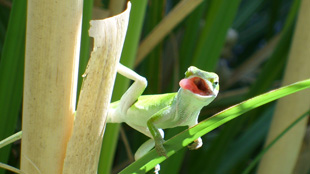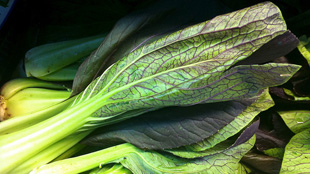 Tammar Wallaby (Macropus eugenii)WIKIPEDIA, THOMAS
Tammar Wallaby (Macropus eugenii)WIKIPEDIA, THOMAS
Kangaroo first-timers
Species: Tammar wallaby, Macropus eugenii
Genome size: Approximately 3 billion base pairs
Interesting fact: The tammar wallaby was the first Australian marsupial to be discovered and is now the first member of the kangaroo family to have its genome sequenced. The small marsupials have a highly synchronized breeding cycle, with most wallabies giving birth around January 22. The females usually mate within hours of giving birth, but then undergo a rare gestation process whereby the embryo remains in a state of dormancy for 11 months before implanting in the uterus. Researchers hope the wallaby’s genome will further illuminate mammalian reproduction.
M.B. Renfree, et al., “Genome sequence of an Australian kangaroo, Macropus eugenii, provides insight into the evolution of mammalian reproduction and development,” Genome Biology, doi:10.1186/gb-2011-12-8-r81, 2011.
Green lizards
Species: North American green anole lizard, Anolis carolinensis
Genome size: 1.78 billion...

Interesting fact: Researchers at The Broad Institute of Harvard and Massachusetts Institute of Technology obtained the first genome sequence of a non-avian reptile from a female anole lizard captured in South Carolina. The reptile genome is expected to offer researchers a better understanding of the evolution of amniotic lineage—which includes lizards, birds, and mammals, and which represents a key adaptation that allowed animals to fully conquer land: the development of hard, waterproof egg shells. They found, among other things, that the reptilian genome has many active transposable elements, or “jumping genes,” from which around 100 human noncoding elements may have been derived.
J. Alföldi, et. al., “The genome of the green anole lizard and a comparative analysis with birds and mammals,” Nature, doi:10.1038/nature10390, 2011.
An Arabidopsis assemblage
Species: 98 strains of the thale cress, Arabidopsis thaliana
Genome size: 157 million base pairs
Interesting fact: Researchers have completed the first phase of the 1001 Genomes Project, an effort that began in 2008, aiming to characterize the genetic variation among 1,001 strains of the model plant Arabidopsis thaliana. By sequencing 98 genomes of A. thaliana strains distributed throughout Europe, Asia, and North Africa, scientists hope to understand how genetic variation leads to differences in phenotype and ultimately to the plant’s ability to adapt to diverse environments. They found, for example, that genetic variation varies geographically, with the greatest variation found in the Iberian Peninsula—a major biodiversity hotspot in Europe—and the least variation in Central Asia—where Arabidopsis colonization occurred more recently, only after the last ice age.
Bok Choy

Species: Chinese cabbage or “bok choy,”
Brassica rapa
Genome size: Approximately 284 million base
pairs
Interesting fact: Brassica rapa is closely related to Brassica napus, or oilseed rape, the world’s second-most important oil crop and a source of vegetable oil. In fact, the oilseed rape is a hybrid of Brassica rapa and another cabbage species, called Brassica oleracea. Therefore, the complete sequence of Brassica rapa gives researchers access to half of the oilseed rape’s complex genome.